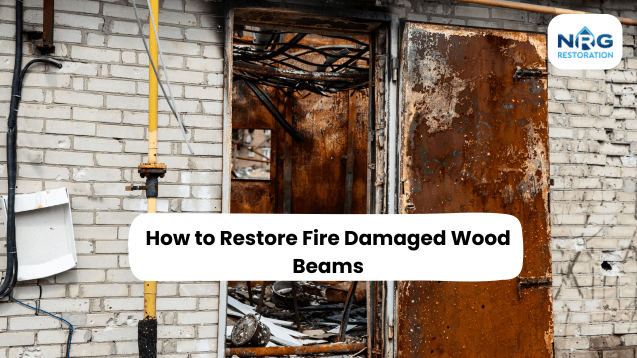A fire can turn your world upside down. The smoke, heat, and flames leave behind a trail of destruction. For homes with exposed wooden beams, the damage often feels even more personal. These beams aren’t just structural – they’re part of the home’s character. If you’re wondering whether those fire damaged wood beams can be saved, the answer is often yes, with the right approach.
Let’s walk through expert tips on how to restore fire damaged wood beams and bring back both strength and beauty to your space.
Your wood beams hold memories, not just structure!
Fire, smoke, water, or mold , don’t let damage rewrite your story. NRG Restoration is here with fast action, full restoration, and real results.
Can fire damaged wood beams be restored?
Yes, in many cases, fire damaged wood beams can be restored if the core structure is intact. It all depends on how deep the damage goes.
Before restoration, professionals check the following:
- Charring Depth: Shallow charring can be cleaned; deep burns may require removal.
- Beam Stability: If the beam is still strong inside, it may not need replacement.
- Smoke & Soot Penetration: The level of contamination tells how much cleaning is needed.
Once the assessment is complete, the restoration process can begin. This involves careful cleaning, repairing, and sealing techniques to save the beams and make them safe again.
What tools and safety gear are needed?
Restoring fire damaged wood isn’t a simple task. It requires safety precautions and the right tools to avoid exposure to toxic residues.
Here’s what professionals use:
- Protective Gear: Respirators, gloves, and safety glasses to protect from smoke particles.
- Wire Brushes and Sanders: For removing charred surface layers.
- HEPA Vacuums: Capture fine soot and dust without spreading it.
- Sealants and Primers: Lock in odors and protect the surface from future damage.
Using the right tools keeps the cleanup effective and safe.
How is the charred surface removed safely?
Removing the burned layer is the first real step in restoring fire damaged wood beams. This is done gently to avoid weakening the structure.
- Dry Brushing: A wire brush scrapes away loose charred particles.
- Low-Grit Sanding: Removes the top burnt layer while preserving the core.
- Soot Vacuuming: A vacuum with a HEPA filter picks up all residue.
After cleaning, the beam is inspected again to ensure it’s solid and ready for deeper restoration.
What treatments are used to restore the wood?
After surface cleaning, it’s time to treat the fire damaged wood to restore its appearance and strength.
- Wood Hardener: Applied to soft areas to reinforce them.
- Deodorizing Solutions: Break down smoke particles to remove odor.
- Stain or Sealant: Brings back the natural color and locks in the surface.
These treatments help the beam look better and last longer. Professional restorers often customize treatments based on how damaged the wood is.
Can fire odors be removed from wood beams?
Yes, odors from fire damaged wood can be strong but not permanent. They come from smoke particles trapped inside the fibers.
Professionals use a few key methods:
- Thermal Fogging: Uses heated deodorizer to reach deep into wood.
- Ozone Treatment: Breaks apart odor-causing molecules.
- Sealing Primers: Lock any remaining smells under the surface.
These steps neutralize odors and prevent them from coming back.
When should a beam be replaced instead of restored?
Not all fire damaged wood beams can or should be saved. If a beam is deeply burned or structurally unsafe, replacement is the only safe option.
Here are warning signs:
- Deep Cracks or Splits: Signs the wood has lost strength.
- Soft or Brittle Texture: Suggests internal burning.
- Unstable Structure: Beam sags, tilts, or creaks under pressure.
Professionals will guide you on what’s salvageable and what needs to go.
How does NRG Restoration help with beam restoration?
At NRG Restoration, we understand how important your wooden beams are to your home. We take a careful and skilled approach to restoring fire damaged wood.
Here’s how our team can support you:
- Thorough Inspections: We check all affected beams for stability and damage.
- Safe Cleaning: Our team removes soot and char without hurting the wood further.
- Professional Treatments: From sealing to structural reinforcement, we tailor solutions to each case.
- Odor Control: We eliminate smoky smells using the best tools in the industry.
We bring experience, care, and the right techniques to every project.
How can I prevent future damage to restored beams?
After restoring your fire damaged wood beams, it’s smart to add extra protection so they stay safe in the future.
- Fire-Retardant Coatings: Add a layer of defense if a fire happens again.
- Regular Inspections: Spot problems early before they get worse.
- Moisture Control: Dry wood resists fire better than damp wood.
Restoration is a second chance. Prevention gives it staying power.
Disasters are personal. So is our help!
Whether it’s water damage soaking your walls, fire damage leaving smoke behind, mold creeping in, or storm chaos tearing through your space, we’re not just contractors. We’re your cleanup crew, rebuild squad, and peace-of-mind providers.
Conclusion
Restoring fire damaged wood beams takes more than scrubbing off soot. It’s about understanding how deep the damage goes and applying expert techniques to save what matters most.
NRG Restoration brings the skill and care needed to protect the beauty and safety of your home. Our team is ready to assess, restore, and support you every step of the way.
